It seemingly started overnight. I must have been 7 years old, and although I don’t remember everything from the very beginning, I remember enough. It’s been 29 years since my symptoms first appeared, and I’ve learned a lot over the years. I know I had anxiety even before the OCD began, although it was mostly separation anxiety. Being a child with OCD is not easy, especially in the early 90s. There will be no sugarcoating it– there were a lot of tears, a lot of screaming, and a lot of frustration, both from myself and my parents. I’ve lived with it for so long at this point, I don’t remember what my young life was like before it.
I think it’s important to get into the basics of OCD, because although everyone’s heard of it at this point, not many people fully understand the intricacies of it.
OCD stands for Obsessive-Compulsive Disorder. For years, OCD was thought of as an anxiety disorder, and while it is, in 2013 it was given its own unique classification because OCD is more complex.
Almost all of those with OCD struggle in two distinct ways, with obsessions and compulsions. A small percentage of people with OCD may have only the obsessions or only the compulsions.
The obsessions are unwanted and intrusive thoughts, feelings, images, and urges that seemingly invade ones mind. The compulsions are the behaviors that someone with OCD feels “driven” to do in order to get rid of the intrusive obsessions and thoughts. The compulsions are done to try to lessen the anxiety that is occurring from the obsessions.
For some, not doing these repetitive behaviors will trigger a voice in our heads telling us if we don’t do it, something bad will happen. This is how it is for me, and it was really difficult to navigate as a young child. For others, not doing these repetitive behaviors will cause severe anxiety, but they won’t have the nagging voice in their heads.
I often say having OCD is like having superstitions, and that’s a really good way of describing it for others to understand better.
Think about the superstitions we learn as kids. Don’t step on a crack or you’ll break your mother’s back. Don’t walk under a ladder, you’ll get bad luck. Don’t break a mirror, you’ll have bad luck for 7 years. Turn off the light 12 times or you’ll die. Touch the wall a certain way or your family will get sick. Put the TV volume on an even number or you’ll get sick.
It may sound dumb, and you might think the obsessive thoughts would be easy to ignore, but it’s not that simple. The anxiety gets so extreme, so intense, that you can think of nothing else. You have to do whatever that little voice in your head is telling you to, or else something bad will happen, and the anxiety will be more than you can take.
Obsessions
Everyone gets obsessions, right? You’re obsessed with that new song you just heard, or a book you just read. But that’s not the same as the obsessions one deals with when they have OCD.
Obsessions are intrusive thoughts that come out of nowhere. These thoughts set root in our brains and stay for however long they decide to. It could be weeks, it could be months, it could be years or decades, it could be the rest of our lives.
The average person might have some of these thoughts, but they’re momentary blips in their heads compared to what someone with OCD will experience. Having these thoughts often, and for how long they’ll occur, can cause someone with OCD severe anxiety, and can get in the way of functioning and everyday life.
The number of things someone with OCD can obsess over is infinite. There are categories for the major obsessions, and some of these include:
- Contamination and Germs
– Germs and disease
– Dirt
– Bodily fluids - Fear Over “Bad Things” Happening
– Fear of harming a loved one.
– Fear of being responsible for for something terrible happening (like a fire, or a death).
– Fear of harming others due to being careless (leaving something on the floor they could trip on).
– Fear of getting a physical illness. - “Just Right” OCD
– Feeling discomfort when something feels uneven.
– Intolerant of things that are out of place.
– Extreme need for organization. - Religious Obsessions
– Overly concerned about offending God, or concern about blasphemy.
– Excessive concern over right and wrong, or morality. - Miscellaneous
– The need to acquire objects, even if they’re not needed.
– The inability to discard items.
– Superstitions about certain numbers and colors.
– Fear of losing things.
Compulsions
The repetitive behaviors, also known as compulsions, are the second part of OCD. A person with OCD does these tasks with the intention of neutralizing, or lessening the anxiety from the obsessive thoughts. Fulfilling these compulsions only offers temporary relief though, as these thoughts will come right back. These rituals can get in the way of everyday life, and become a huge burden.
Much like the obsessions, there are immeasurable amounts of compulsions one may acquire. Some are:
- Checking
– Making sure windows and doors are closed and locked.
– Making sure appliances are off.
– Water taps.
– Seeking assurance from others.
– Seeing if you made a mistake. - Washing and Cleaning
– Washing hands or showering excessively.
– Cleaning the house. - Repeating
– Rereading or rewriting.
– Repeating body movements (tapping, touching, or blinking).
– Repeating routine activities (going in and out of doors, etc.) - Miscellaneous
– Putting things in order or arranging things until they “feel right”.
– Counting to a specific number.
– Reviewing or going over conversations or events that have happened.
Together, obsessions and compulsions work in harmony to create the perfect storm of chaos in our minds. A lot of people assume that people who have OCD are just overly clean, overly organized individuals. They don’t know and don’t understand the pandemonium that occurs inside our brains. It’s not the way it’s been portrayed in most TV shows and movies, it’s much uglier, and much more messy.
The Beginning
The anxiety was always there. I had trouble leaving my mom sometimes during dance class when I was 3, and I would stand blocking the front door and sob if she was going to her friend’s house for their “girl’s night”. I had no OCD symptoms before though, and the anxiety was just linked to being without my mom.
At 2 or 3 years old, I had a really high fever of over 103°. My mom called the doctor because she was worried, asking when she should bring me to the hospital. He responded “Mother, you don’t.” I believe that was the fever where I stood at the top of the stairs and was about to try to fly, when one of my parents caught me. When the fever went down, I was left with a stutter. My mom took me to the doctor, and they told her not to worry, it would go away. Well, it did, but it took about a year.
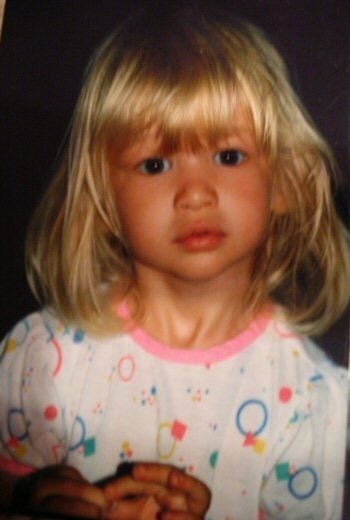
Me around the age of 3.

Me at 4.
Everything changed rapidly around 1992, when I was 7. My OCD symptoms started out of nowhere, and there were a couple things that happened very close to each other that may have been triggers for it.
It’s been known that possible triggers for OCD could be a traumatic event, and I had one happen when I was young. I don’t want to get into specific details because the people involved may be reading this (although I doubt it). I will say it was not a molestation or anything of a sexual nature, but an event that terrified and traumatized me as a child.
Around the same time, I developed Strep throat. I had Strep a decent amount as a kid, usually once a year. At the time, no significance was given to the Strep, because PANDAS did not exist yet, so we always assumed the traumatic event was my trigger.
PANDAS stands for Pediatric Autoimmune Neuropsychiatric Disorders Associated with Streptococcal Infections. It affects children typically from the age of 3 up until puberty. I only learned about it in the last few years, when my primary doctor told me about it, asking if that was the trigger for my OCD. She told me about it, and I was shocked to hear the details. I immediately went home to start Googling more.
PANDAS occurs when OCD appears following an infection of Strep throat. These symptoms seem to appear overnight, and can include both OCD and vocal and motor tics. PANDAS wasn’t discovered until 1998, 6 years after my OCD symptoms began. The exact science behind it is complex, but this website has informative information about it. I could do an entire blog post just on PANDAS, but that’s not the purpose of the one I’m writing now.
It’s crazy to me that PANDAS was discovered while I was still a child and actively getting treated, yet no one ever told my parents about this and suggested a possible connection. Obviously it wasn’t discovered yet when I was diagnosed, but I was only 12 or 13 in 1998.
I don’t remember when my symptoms first appeared, but I remember the feelings and frustrations I felt at the time.
One of my biggest compulsions was (and still is) what I called double touching. If I touched something with a a body part (a hand, finger, foot, etc), I would have to do the same with the other side. I had to touch the item at the same angle, the same way the other body part did. If it didn’t, the anxiety would be extreme and it would linger.
And if I didn’t do the double touching ritual? Then the obsessions would start. And my recurring obsession? Well, they’ve changed and altered over the years a bit, depending on what was going on with my life, but there were 2 very distinct ones that would always be present. Either my family would die, or I’d throw up. My two biggest fears in the world, shoved into my brain for me to do nothing but think and obsess about for hours, days, and now almost 30 years.
To this day, my most common obsession is related to the fear of my family dying. I can spend hours fixated on every aspect of it. These thoughts could not be more unwanted, but they are seemingly forced into my brain by some unknown source, and they will not budge.
My decision making skills were a real problem after an experiment my teacher did in Kindergarten when I was 4 or 5 years old, when she decided to teach us about choice and decision making. She had a bag full of jellybeans, and held it up. She said anyone who wanted the jellybeans should stand on one side. Most of the class went to one side, so I followed. Then she held up a huge tray full of jellybeans, and said anyone who didn’t stand to the side was going to get rewarded with the tray full, because they made the decision to wait to see if there was something better coming. I stood there dumbfounded. Something better??? The kids that weren’t standing with me didn’t know to wait for something better, they didn’t come to the side because they didn’t like jellybeans.
This psychological test was not something a teacher should have dabbled in with young children. To this day, I struggle with horrible indecision, and it’s really hard for me to make any actual decision about anything, even as little as where to get dinner or what to eat.
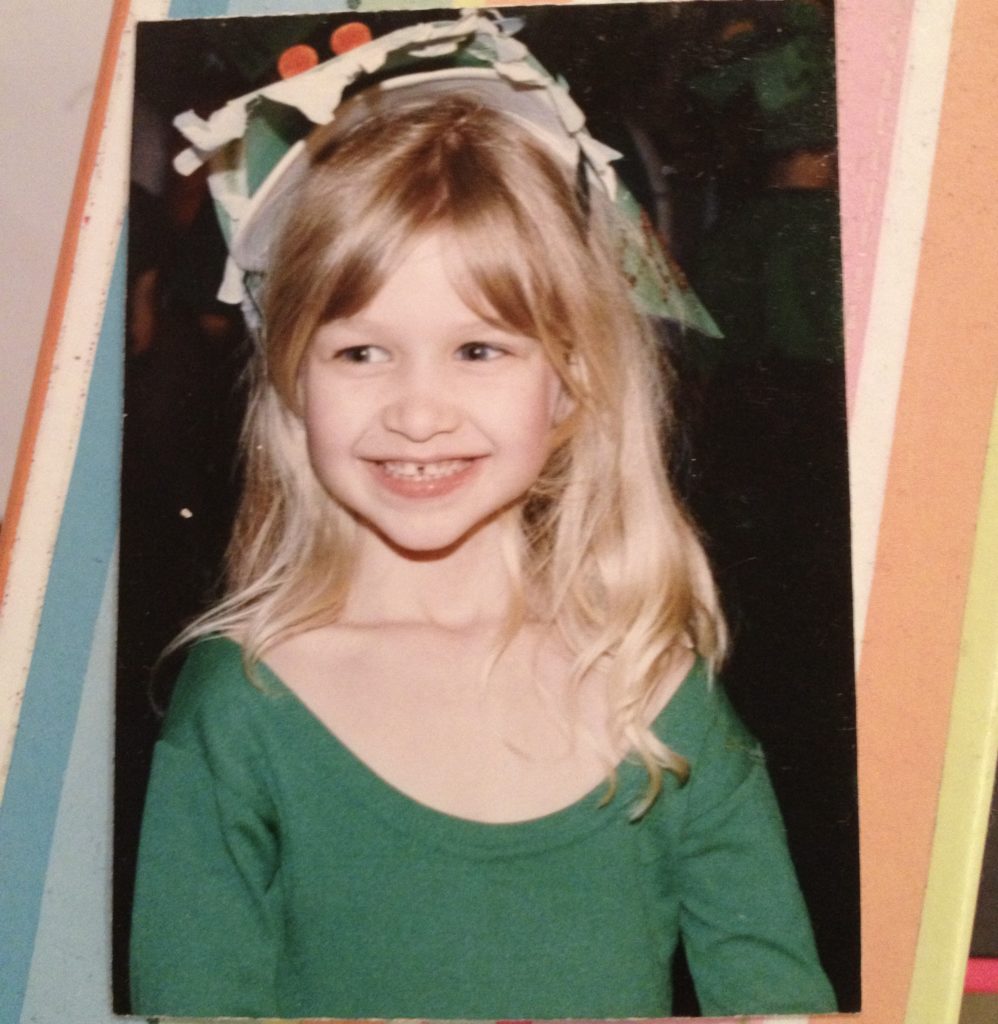
Me dressed as a crocodile for a show in kindergarten.
School was always a place that was hard for me for a number of reasons no one at the time understood. Early in the morning, before school started, was the worst time of the day for me, by far. My anxiety would be high, and every little thing would frustrate me. There was only a short amount of time, and I had a number of “rituals” that felt like they needed to be done. These rituals could change from day-to-day, it was whatever popped into that annoying brain of mine. Sometimes it was having to open and close the door until it “felt right”, or shutting the light off and on until my anxiety decided enough was enough.
Many hours were spent turning light switches on and off until I would start crying because I hated that I felt like I “had” to do it. It’s difficult enough to deal with as an adult, but as a child, you don’t know why you feel like you need to do these compulsions. You don’t understand brain chemistry at 7 and 8 years old. I was always told it was because I had a “chemical imbalance”, but when I look that up now, it says recent research shows that may not be the case. I don’t know, because I’m not in the loop much with OCD research and studies.
Socks were a big hurdle for me. Such a simple thing, right? Wrong. The seam on the sock would drive me crazy, and if it wasn’t centered just right on my foot, I could not put my shoes on. The feeling of the seam was a nightmare, and caused a lot of tears in the first few years.
Remember leggings with stirrups? Nope. Couldn’t do it. They were popular in the 80s and early 90s, and I wore them a few times. The feeling of the strap on the arch of my foot was too much for me to handle. I can still feel it now, all these years later, as I write this. It makes me itch just thinking about it. Anxiety city over here.
With dozens of obsessions and compulsions at this point, my mom took me to 2 local psychiatrists to try to get me diagnosed. Both told my mom there was nothing wrong with me. There started my journey with a lifetime of bad doctors. She even asked my teachers if they noticed my OCD symptoms, and they denied anything, telling her I was fine.
My mom was adamant, and knew I had OCD; my symptoms were textbook. She finally took me to a children’s hospital, and they diagnosed me with OCD in under 5 minutes. My mom was relieved. My memory of this time isn’t the best, but I do remember going to one local doctor, only for my mom to be upset with the outcome. I also remember going to the children’s hospital, as their doctors would become my go-to for a psychiatrist and psychologist well into my teen years.
At the age of 8, I was finally diagnosed with OCD and was put on Prozac. What happened next was something I’m still coming to terms with, but have a hard time.
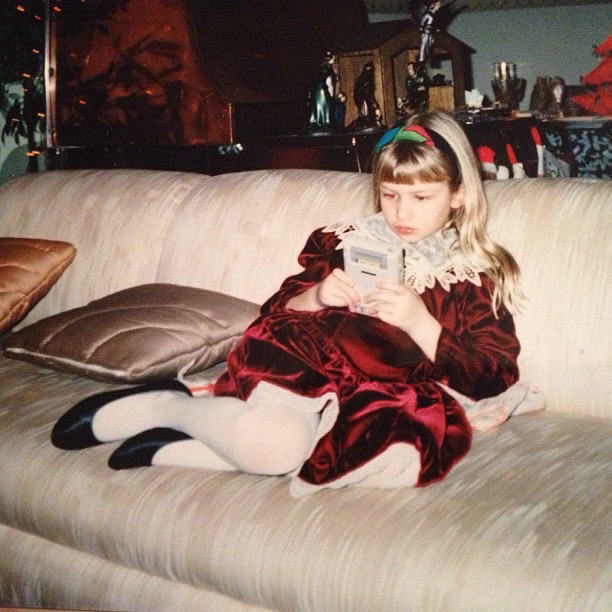
Not long after diagnosis, at 8 or 9.
I gained weight rapidly, so much so that I looked like I was on Prednisone. I ballooned fairly quickly, and went from an extremely skinny little girl, to a chunky one. The bullying started soon after. A lot of the weight went straight to my stomach, and never went away, even to this day.
I want to share more about this, but I’m extremely vulnerable about the way my body looks, and I know it wouldn’t look like this if I wasn’t put on Prozac and gained weight so quickly. I also know I couldn’t have gone on without medication.
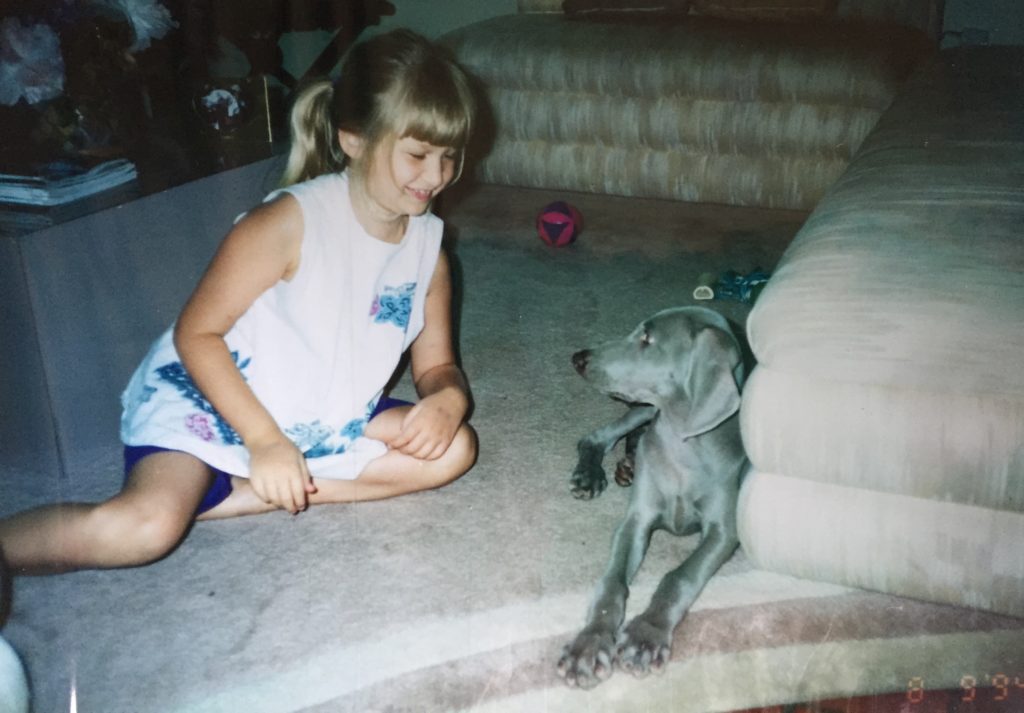
August of 1994, age 8 (a month away from turning 9).
I’ll never forget the time I was at my childhood best friend’s family barbeque. We grew up like sisters, and all of her extended family knew me well (so well they always confused her and I because we looked so alike, aside from her being a year older and a foot taller). Every year they’d have a family barbeque, and the year before I was still stick-thin. This year my body had changed, and I looked different. My best friend’s aunt came up to me and said “Wow! Looks like your mother’s been feeding you well.”
That was one of the first inklings that I remember about my “new body”. I was 9 years old and mortified. It stuck with me for years. It’s still with me now, all these decades later. That was one of the first memorable triggers for my Body Dysmorphic Disorder.
In school, my biggest compulsion (and still is to this day) was realized. Writing. At first, it was erasing, since we were using pencils in 1st and 2nd grade, when my symptoms first started. I would erase so much, my pencils would have no erasers left, and I’d create holes in the thin paper.
When I was in 2nd grade, we were asked to write the alphabet. I believe we had to write it in script, but I can’t remember for sure. As I was writing it out, I needed to erase. A lot. The letters were not coming out “right”, and didn’t feel “right”. My teacher came over to me, took my pencil, and put a piece of tape over my eraser, and told me I wasn’t allowed to take it off. My anxiety went through the roof, and I was left sitting there, 7 or 8 years old, crying because I wasn’t allowed to erase the “wrongness” of the letters I’d written out.
My teacher knew I had OCD. She was one of the teachers who told my mom before I was diagnosed that there was nothing wrong with me. She was in denial, and thought she could “teach me” or “correct me”. The shortage of sensitivity in a lot of teachers has been clear to me from day one, and I’ve experienced so much lack of empathy and lack of understanding over the years. A lot of people talk about how much teachers have changed their lives for the better, and I can honestly say that I don’t have a single teacher that ever has gone the extra mile for me or inspired me in any way. Instead, I was treated with disrespect, bullied, harassed, and left to struggle on my own (more on that later).
As I grew older, the pencils turned into pens, and the erasing turned into going over the letters over and over, or crossing out whole words until it felt “right”. A circle on a test, filling in the bubble on a scantron, or writing an essay could take me double the amount of time as someone else, because I had so much anxiety over each and every stroke I was writing. Teachers didn’t care, and they certainly wouldn’t give me more time.
My psychologists would try different treatment techniques on me over the years, including CBT (Cognitive Behavioral Therapy). CBT is a type of psychotherapy treatment that helps you learn how to identify and change destructive or disturbing thought patterns that have a negative influence on behavior and emotions. CBT focuses on changing these negative thought patterns, and replacing them with more objective, realistic thoughts.
Sometimes it would be beneficial to me, but usually it wouldn’t. It depended on the particular thought pattern we were working with. I think I had more luck with changing it as I got older than when I was a child, as I was too young to really understand what was objective and realistic.
One of my psychologists had me name the voice in my head that was feeding me the obsessions and compulsions. At a young age, I didn’t know many “bad” things, so I named it “The Devil”.
I would say “The Devil is telling me if I don’t do this, my family will die.” Thinking back now, that’s horrifying! But when you’re a child, what else would you name the “bad voice” in your head? I remember her asking me to draw it out, and I would pay to see those drawings today! I assume I drew a red, horned character with a pitchfork.
In 3rd grade, I went from a private school to a public school, and I was miserable about it. I left all my friends behind, and started at a new school where I was immediately an outcast. The bullying started at this school, and for years I was so angry with my mom for pulling me out of the other school. I learned later that she had to, because the private school didn’t offer remedial reading courses, and I needed a little more help than they offered. I think my problem wasn’t in reading, per se, but with concentrating enough to actually read. The obsessive thoughts were running a marathon in my head, and I found it extremely hard to focus.
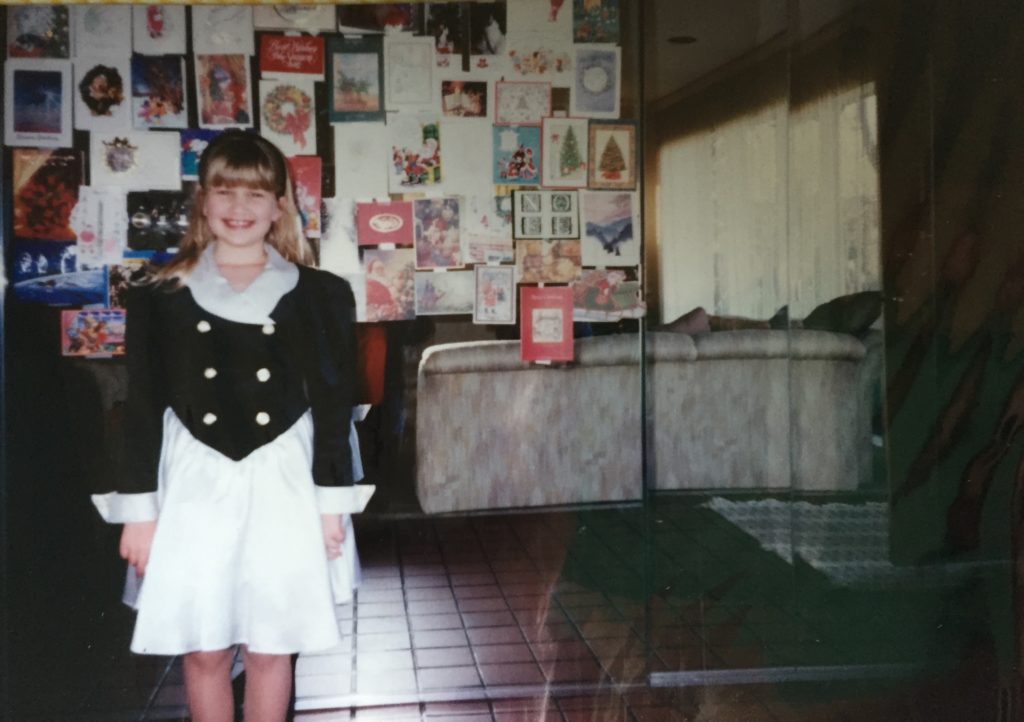
Me on Christmas in 5th grade, you can see a bit of the weight I’ve gained. This was just the beginning.
Part 2, “The Middle“, is now up, and so is the final part, “29 Years Later“.
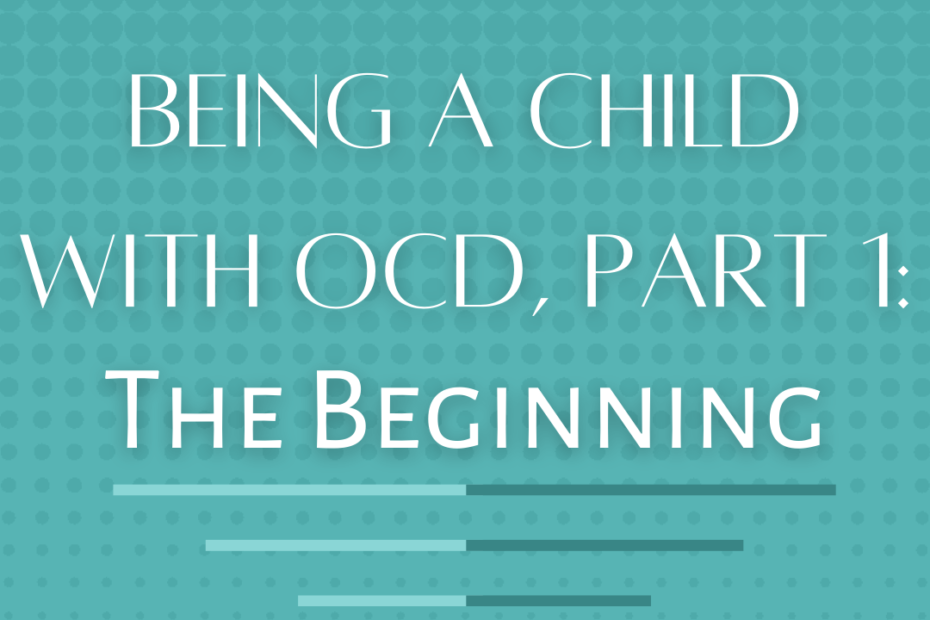
Pingback: Being a Child with OCD, Part 2: The Middle - Invisible Chaos
Pingback: Being a Child with OCD, Part 3: 29 Years Later - Invisible Chaos
Pingback: The Aftermath of Years of Medical Gaslighting - Invisible Chaos
Pingback: ADHD: Getting Diagnosed in Your 30s - Invisible Chaos